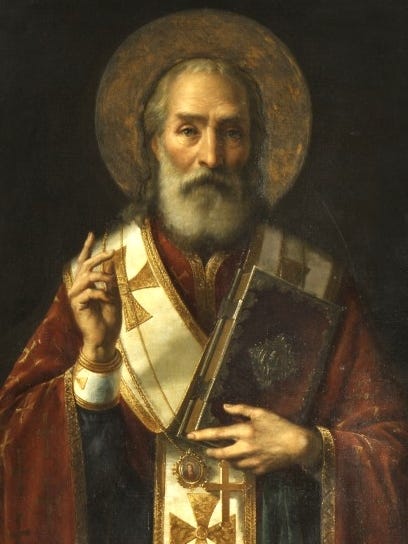An esteemed colleague of mine recently posed this question: “Is Santa Claus circumcised?” It’s a fascinating topic that delves into early Christianity’s apostolic debates, the melding of Christian legends with Norse mythology, and evolving trends in modern medicine. Let’s peel back the foreskin on this complex issue.
First of all, who is Santa Claus? He is an evolving figure with roots across two millennia. For the sake of this discussion, we will look at three different instantiations of Santa Claus:
Saint Nicholas, an early Christian saint from the fourth century
Sinterklaas, a Dutch legend with a characteristic red robe and beard
Mall Santa, the bearded boomer your kids wait in line to see
Saint Nicholas – 🚫✂️🍆
Saint Nicholas of Myra is the patron saint of sailors and children and known for spontaneous gift-giving. He was born around 270 CE in a port town in Anatolia (modern day Turkey) within the Roman Empire. To speculate on his circumcision requires understanding the contemporary context.
Circumcision was a controversial topic among early Christians. Christianity grew out of Judaism, wherein circumcision was a non-negotiable prerequisite. Circumcision was not just a ritual, but a divine covenant. Big J himself was certainly circumcised.
“This is my covenant, which you shall keep, between me and you and your offspring after you: Every male among you shall be circumcised. … Any uncircumcised male who is not circumcised in the flesh of his foreskin shall be cut off from his people; he has broken my covenant.” (Genesis 17:10–14)
However, this became a point of debate in early Christianity: did gentile (non-Jewish) converts to the Jesus movement have to be circumcised? Two main factions emerged: James and the Judaizers stuck close to Jewish traditions of circumcision, whereas Paul’s followers argued that faith in Christ alone was sufficient. This disagreement was resolved at the Council of Jerusalem (~50 CE), which decided that gentile Christians did not need to be circumcised. Moreover, Paul was particularly active in Anatolia, so his non-circumcision doctrine had greater influence there.
Two centuries later, Saint Nicholas was born to two wealthy, devout Christian parents. By that time, Anatolian Christians were predominantly gentile, and there is no evidence that Nicholas’ parents were part of a Jewish enclave. At the time, the Roman empire was accepting of Christians but skeptical of Jews, and gentiles likely avoided circumcision in order to stay in the Romans’ good graces. Thus, it is likely that Saint Nicholas himself was not circumcised.
Sinterklaas – 🚫✂️🍆
Our modern image of a fat man with a white beard and red robes traces its roots to the Dutch legend of Sinterklaas (a contraction of Sint-Nicolaas). Every winter, Sinterklaas arrives from Spain riding a white horse and accompanied by his Moorish assistant Zwarte Piet (“Black Pete”) to deliver gifts via chimney. Traditionally, Pete wears full-on blackface, but this has become controversial for obvious reasons. Modern adaptations of Pete use subtler soot smudges instead. Dutch immigrants brought this tradition to America where it merged in the melting pot to become the modern Santa Claus we see today.
The Dutch Sinterklaas itself was likely a fusion of various local traditions. Many scholars draw parallels to the Norse myth of the wild hunt. Odin leads the hunt, riding his white horse Sleipnir and accompanied by two black ravens. Like Black Pete, those ravens would eavesdrop at a chimney to inform Odin about the moral behavior of the mortals inside. As the Germanic tribes were Christianized, many local traditions merged with Christian theology, and it seems likely that Odin’s wild hunt merged with Saint Nicholas’ gift-giving to create Sinterklaas.
Christianity reached the Germanic tribes gradually between the 4th and 11th centuries via the Roman empire rather than Israelite migration. Sinterklaas and the people who celebrated him were likely not circumcised. Odin certainly wasn’t.
Mall Santa – ✅✂️🍆
There’s a ~75% chance the Santa Claus impersonator at your local mall is circumcised.
For most of American history, circumcision was rare and primarily practiced by Jews and Muslims. This started to change in the 1870s when doctors like Lewis Sayre began to popularize the procedure. The justifications were medical and moral, albeit secular: circumcision was supposed to prevent masturbation, reduce the spread of sexually transmitted infections (STIs), and overall considered to be modern and hygienic. Circumcision peaked in the 1950s when over 80% of white males were circumcised, often without explicit consent from parents.
Since then, Circumcision has been on a gradual decline. There is little evidence that circumcision is healthier or cleaner. Anecdotally, it has no impact on masturbation. Beginning in the 1970s, The American Academy of Pediatrics (AAP) has released statements expressing skepticism about the benefits of circumcision, and downgraded it to “not medically necessary” in 1999. Circumcision is still prevalent but rates have dropped to around 60% nation-wide, and as low as 25% in California.
Globally, circumcision rates vary a lot, and are primarily dictated by religious demographics. Muslim, Jewish, and African Christian regions frequently practice circumcision, but rates are below 10% for most of Western Europe, South America, and non-Muslim parts of Asia. South Korea is a notable outlier, with high circumcision rates due to American influence after World War II.
Your local mall Santa is likely a white American born in the 1960s, and thus is very likely to be circumcised.
Etymology Addendum
“Circumcision” means “to cut in a circle”. Technically, whenever you cut a circle out of paper or use a circular cookie-cutter, you are performing circumcision.







